The AquaLeap 2020 Newsletter
We take a close look at the ongoing research within the AquaLeap consortium project, which is applying innovation in genetics and breeding to help advance UK aquaculture.
28/08/2020
Since it began in January of 2019, the BBSRC and NERC funded AquaLeap project has generated great interest amongst the academic and industry communities. For example, during July 2020, AquaLeap researchers presented their findings as part of the Aquaculture Research Collaborative Hub's webinar series to an audience of over 100 from across the world who found out about the project's discoveries and progress so far. This event helped the AquaLeap project engage with a wider audience and further discussion of how advances in genetic technology can support safe and sustainable aquaculture worldwide—which, in turn, has been a key priority for the whole team since the collaboration first started.
AquaLeap is a collaboration between academic and industry partners, with the Universities of Edinburgh, Stirling, Aberdeen, and Exeter all involved. We reached out to researchers within the AquaLeap project, whose efforts focus on salmon, lumpfish, lobster, and flat oyster, to gain an update of their research progress thus far over the course of 2020. Below you'll find updates from each team, detailing the nature of their studies and the approaches they've taken towards the main goals of AquaLeap.
The AquaLeap project is fortunate to benefit from superb researchers who have made significant progress to date on advancing genomic tools and techniques across the targeted aquaculture species. In turn, we expect that the second half of the project will see these tools being applied to tackle major applied research questions, ultimately helping the UK aquaculture industry capitalise on the potential of genetics for improved production.
Improving CRISPR genome editing in salmon cell lines and embryos
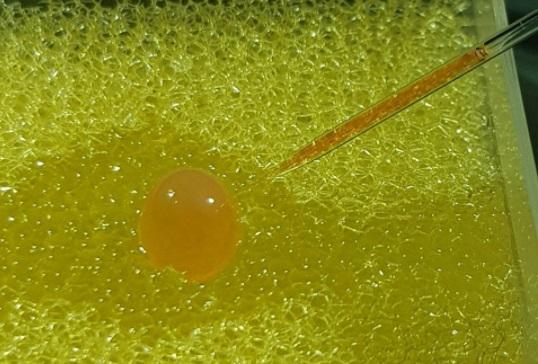
Partners: The University of Edinburgh and Hendrix Genetics
Report by Yehwa Jin (University of Edinburgh)
The AquaLeap project seeks to improve genome editing techniques in aquaculture species through several different methods and to apply genome editing to identify the causative factors underlying a major locus affecting disease resistance in salmon. Dr Yehwa Jin, a postdoctoral research fellow in Professor Ross Houston’s research group at the Roslin Institute, outlines how she and her colleagues have made progress towards these goals.
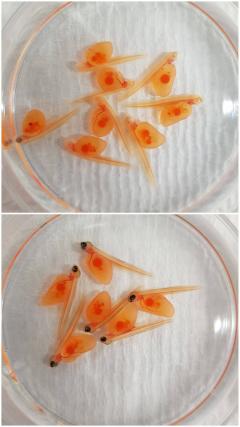
“Current aquaculture breeding programmes have some limits; we can find genomic regions or candidate genes associated with certain traits using genomic analysis tools such as GWAS (genome-wide association study) or RNA-Seq (Ribonucleic acid-sequencing), but there are still knowledge gaps in the functional mechanisms underlying these associations. Genome editing can help identify causative variants, and has major potential to improve production. Currently the most powerful and widely used genome editing technique is called CRISPR/Cas (clustered regularly interspaced short palindromic repeat/CRISPR associated protein), which is derived from the bacterial antiviral defence system. To apply this technique in aquaculture research, it is essential to optimise this tool for aquaculture species. Thus, the first task in the AquaLeap project was to optimise and improve genome editing efficiency in Atlantic salmon, one of the most important aquaculture species worldwide.
“For efficient in vitro genome editing, viral vectors have been widely used to transduce cells but were not effective for many salmonid cell lines. We therefore used a different approach: electroporation of ribonucleoprotein (RNP). Together with Dr Remi Gratacap, a postdoctoral researcher in our group at the Roslin Institute, we optimised the settings for efficient genome editing in Atlantic salmon cell lines by testing different concentrations of Cas9 RNP and electroporation settings. Then we demonstrated the efficiency of the RNP editing approach in various salmonid cell lines including Atlantic salmon, rainbow trout and chinook salmon. As a result, we could set up highly efficient in vitro genome editing platform in various salmonid cell lines, showing over 90% editing efficiency with Cas9 RNP and 60-70% with Cas12a. The result is available as preprint on bioRxiv.”
You can access the results of Yehwa and her colleagues' study through this external link.
“To optimise in vivo genome editing in salmon, we have tested various ways to deliver CRISPR molecules into salmon embryos (and different Cas effectors). So far, pronuclear microinjection of Cas9 RNA and gRNA using a handheld injection system resulted in a 50% hatching rate compared against an 80% rate within the non-injected control. As a proof of concept, we knocked out a pigmentation gene (slc45a2); approximately 20% of the group showed albino phenotype, indicating successful knockout.
“We now aim to improve the survival and in vivo editing efficiency further. These tools will help us to validate and identify causative variants for resistance to infectious pancreatic necrosis virus (IPNV) in salmon using the optimised in vitro and in vivo genome editing platforms. Resistance to IPNV has been shown in earlier research including our team to be under the control of a single major effect locus. As such, it will be a good case study for testing the impacts of genome editing on disease resistance in salmon. Target resistance genes have been successfully edited in vitro, and these edited cell lines are now being challenged with IPNV to evaluate the impact of the edits on viral replication. Based on these results, the most promising edits will be tested in vivo, by editing salmon embryos and then performing an IPNV challenge in collaboration with the Centre for Environment, Fisheries and Aquaculture Science (Cefas) and Hendrix Genetics. We also expect these optimised genome editing tools will be highly useful for validating and identifying the causative factors for various traits of interest.”
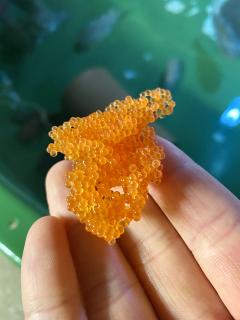
Genomic tools to enable selective breeding of Lumpfish
Partners: The University of Stirling and Otter Ferry Seafish Ltd
Interview with Andrew Davie (University of Stirling)
An important goal of AquaLeap research is to move towards the first selectively improved Lumpfish for UK aquaculture. Andrew Davie, a Senior Lecturer at the University of Stirling’s Institute of Aquaculture, provided us with a report on the work he and his team have undertaken in 2020.
“The Institute of Aquaculture is working closely with Otter Ferry Seafish Ltd to develop and subsequently apply genomic tools to inform captive broodstock selection,” he explains. “Trait improvement via selective breeding would give Otter Ferry a competitive advantage, and move towards a sustainable supply of lumpfish with enhanced performance for lice control in the UK.”
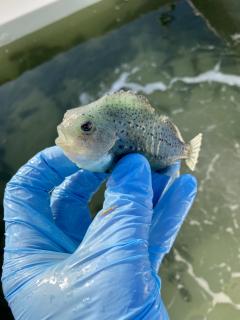
While the Spring and Summer of 2020 were set to see significant advances in activity, the COVID-19 lockdown resulted in significant delays due to both the closure of the Institute’s facilities and the restriction of access for Otter Ferry. These measures helped shield site staff through challenging times—and while they restricted activity, they did not prevent all work from proceeding. Dr Thomas Cavrois-Rogacki, Otter Ferry’s Research and Development Manager, has continued to work on the development of a captive broodstock throughout the lockdown period in preparation for the return to active research. “Through their work this spring, OFS now maintain a population of over 500 potential broodstock onsite, originating from 3 different sources,” says Andrew. “During lockdown, the OFS staff have begun the task of microchipping the animals, phenotyping them, and archiving fin biopsies for later genetic analysis.” The animals in question range in weight from around 100g up to 2kg, with the first recorded spawning (of the animals in the oldest cohort) occurring in July.
That’s not all, either; Andrew explains: “During Spring 2020, we developed a panel of over 200 candidate SNP markers for the species which associate with traits of commercial interest including sex, weight, length and condition factor. Going forward, the performance of the markers requires further validation before moving on to the development of a low density SNP panel. In Autumn 2020, we intend to begin applying this marker suite to the profiling of selected stocks in the OFS broodstock which will subsequently inform the development of a selective breeding plan for the 2021 season. All being well, within the timeframe of the project, we will see the creation of ‘improved’ lines of captively produced lumpfish being made available for commercial deployment which would be a significant milestone for the sector.”
You can access the University of Stirling's AquaLeap page through this external link.
Developing Genomic Resources for European Lobster
Partners: The University of Exeter, the National Lobster Hatchery, and the Centre for Aquaculture Environment, Fisheries, and Aquaculture Science
Statement from Eduarda Santos (University of Exeter)
One key part of AquaLeap is sequencing of the European Lobster genome and studying genetic and epigenetic determinants of growth to enable future aquaculture, fisheries management, and conservation.
Dr Eduarda Santos and Dr Jamie Stevens, both Associate Professors of Environmental Biology at the University of Exeter, are co-leading the lobster research efforts, together with Dr Carly Daniels of the National Lobster Hatchery and Dr Ronny van Aerle of the Centre for Aquaculture Environment, Fisheries, and Aquaculture Science (Cefas). The project is being implemented by Dr Tom Jenkins, a Postdoctoral Research Fellow at the University of Exeter. The team also benefits from the support and knowledge transfer with other partners within the AquaLeap programme, including Xelect Ltd and the Roslin Institute, and from working closely with the Exeter Sequencing Facility. Eduarda and her team have provided us with a report of their mission and the progress the team has made.
“The European lobster (Homarus gammarus) is an iconic species important for the ecology of marine ecosystems and economy of coastal regions across its geographical range. Recently, this species has attracted attention as a potential aquaculture species because of its high economic value and the increasing pressure on its fisheries. However, lobsters grow relatively slowly; in the wild they do not reach catchable sizes until they are 5-7 years old. In this project, our aims are:
- to develop genomic resources for the European lobster to facilitate research and management of this species
- to identify potential genetic and epigenetic determinants of growth to inform on future aquaculture and management programmes
“In collaboration with the National Lobster Hatchery, we have now collected samples from over 190 lobsters with a known growth history, which will form the basis for all the genomics and biological analysis conducted in this research project.”
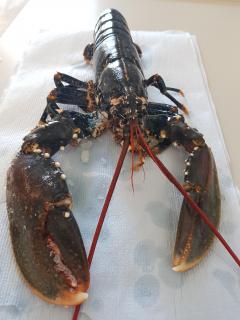
The work done on this project is being implemented in two phases—the sequencing, assembly and annotation of the lobster genome coming first, followed by a second task: identifying genetic and epigenetic determinants of growth in European Lobster. Her report provides further detail:
“Our team have worked with Dr Aaron Jeffries who manages the Exeter Sequencing Facility to sequence one individual male European (named Colin) using the PacBio sequencing platform and generated over 9 million reads, which corresponded to over 100 billion bases. Initial assemblies have generated between 5,000 and 6,000 contigs and quality analysis indicated that these are high quality assemblies containing almost all essential genes (>94 %) present in the BUSCO (benchmarking universal single copy orthologs) database. We are now working towards improving and annotating this draft genome assembly.
“The second phase aims to identify genetic and epigenetic determinants of growth in the European Lobster. We hypothesise that the environment, the genome, and the epigenome of an individual will interact to determine the rate of growth. In order to test this hypothesis we first aimed to identify single nucleotide polymorphisms (genetic variants) that associate with differential growth in this species. To do this, we have extracted DNA from over 190 lobsters with a known growth history and are now in the process of conducting RADSeq to identify genetic regions that are associated with differential growth in this species. This information will serve as an initial step to investigate whether there is a genetic component for fast growth in lobster and to identify genetic markers of use in the selection of fast-growing individuals.
“In parallel, we are developing strategies to investigate for epigenetic features associated with fast growth in this species. We will investigate if cytosine methylation is a feature in the genomic architecture of the European Lobster and if so, we will search for differential methylated regions associated with growth in a selection of lobsters identified from the 190 individuals included in the growth and RADSeq experiments.”
Sequencing the flat oyster genome and analysing copy number variation in salmon
Partners: The University of Edinburgh, Hendrix Genetics, Xelect Ltd
Report by Manu Kumar Gundappa and Dan Macqueen (University of Edinburgh)
Professor Dan Macqueen (Personal Chair of Integrative Fish Genomics), Dr Manu Gundappa (Postdoctoral Research Fellow), and their collaborators have been undertaking research targeted at assembling a reference genome for the European oyster, and analysing copy number variation in the genome of Atlantic salmon across two key objectives.
Sequencing and assembly of a reference genome for the European flat oyster
“European oyster (Ostrea edulis) is a keystone species with increasing aquaculture and commercial value along the coast of many European countries. The species has been harvested since prehistoric times, contributing greatly to human nutrition. However, overexploitation, pollution and disease outbreaks have led to a drastic decline of European oyster beds with the majority of current production coming via aquaculture. Bonamia ostrae is a protist causing persistent infections in flat oyster, severely hindering aquaculture production and threatening wild populations. Controlling the infection forms the key to the successful recovery of this species. Our project aims to generate a high-quality reference genome assembly for flat oyster to support the development of genetic tools to investigate genetic resistance to Bonamia, which is AquaLeap research led by Drs Chantelle Hooper (Cefas), Tim Bean (University of Edinburgh), and Professor Ross Houston (University of Edinburgh). The genome resource will also support the ongoing conservation and restoration of this species, in addition to providing a strong base to initiate selective breeding programmes.”
Progress
“An adult individual was sourced from Whitstable in the south of England and used for genome sequencing. This individual (“Eddy”) was sampled for a panel of tissues, with gill tissue selected to extract genomic DNA for the downstream sequencing. The other tissues will allow us to predict genes expressed from the genome through RNA sequencing analysis. High molecular weight genomic DNA was used to generate long read sequencing data on the Oxford Nanopore PromethION platform in collaboration with Edinburgh Genomics (University of Edinburgh). 143 billion DNA basepairs (bp) of sequence data was generated with a mean length of ~6,700 bp and more than half the sequences being >9,300 bp in length.
“Using various bioinformatic strategies, we have generated a highly contiguous assembly with the entire genome being assembled into around 2,500 contig sequences. Preliminary analysis for the quality of the genome suggests it is highly complete in terms of the represented genes. We are currently generating a chromosome-level assembly using a proximity ligation-based Omni-C technique, with the aim of releasing an assembled and annotated genome to a public database by the end of 2020.”
Role of structural variants in amoebic gill disease resistance in Atlantic salmon
“Structural variants (SVs) represent genetic polymorphisms >50bp in size and include deletions, duplications, inversions and copy number variations. They contribute to normal genetic and phenotypic variation by impacting gene function and expression, and therefore are likely to be controlling traits of interest in aquaculture species including Atlantic salmon—an idea that remains largely untested. A key objective within AquaLeap is to test the association of SV genotypes with resistance to amoebic gill disease (AGD) in Atlantic salmon, a collaboration with Hendrix Genetics. Using SV discovery methods developed within the Macqueen lab, we will generate SV calls and genotypes across the genomes of 300-400 salmon individuals with AGD resistance phenotype measurements, sampling parents and offspring from multiple families within a commercial population. The study is designed to define the role of SVs in AGD resistance heritability, identify regions in the genome containing SVs linked to AGD resistance, and discover regulatory effects of SVs influencing AGD resistance, for example by altering immune gene expression.”
Progress
“Our focus until this point has been on enriching our database of SVs in Atlantic salmon. In addition to 15,483 high-confidence SVs previously discovered from an analysis of 492 Atlantic salmon genomes (Bertolotti et al 2020; in revision), which involved collaboration with AquaLeap partner Xelect Ltd, we generated new SV calls in additional populations.”
This external link provides access to the relevant research article.
“This includes 20 animals from the AGD-phenotyped population mentioned above, provided by Hendrix Genetics, from which 3,044 novel SVs were detected. We are currently planning for a larger whole genome re-sequencing experiment using the 300-400 individuals, with samples expected to be sent to a sequencing provider in the autumn. We expect to receive the raw data back and generate new SV calls in these fish towards the end of 2020, allowing planned analyses to proceed in early 2021. These analyses will include genome-wide association and QTL definition using SV data directly and in comparison to SNP markers, expression QTL analyses, and tests of SV data in genome prediction accuracy. These analyses are in collaboration with Dr Diego Robledo and Professor Ross Houston, who have taken similar approaches previously using genome-wide SNP markers.”
The full article from G3 is available through this external link.
Review Publication in Nature Reviews Genetics
Members of the AquaLeap team from Universities of Edinburgh, Aberdeen, Stirling, and Exeter wrote a review entitled “Harnessing genomics to fast-track genetic improvement in aquaculture” which was published in the July issue of Nature Reviews Genetics (and featured on the front cover!). The article provides a timely overview of the potential of genetic and genomic technologies to speed up domestication and genetic improvement of aquaculture species in a sustainable manner.
The review article is accessible via this external link.
This news article explains how AquaLeap helped create the review article.
More Information
Additional AquaLeap articles and resources are now available online:
This article provides more information on the start of the AquaLeap project.


